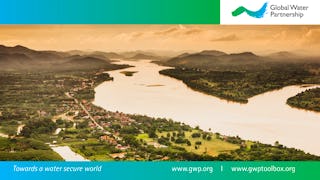It is well known that water treatment at the household level can lead to dramatic improvements in drinking water quality. But does Household Water Treatment and Safe Storage (HWTS) also have global relevance? What are the potential treatment solutions and how do they function? Is there a standard strategy for successful HWTS implementation, or can we identify key components which make programs more likely to succeed?



Introduction to Household Water Treatment and Safe Storage


Instructors: Rick Johnston
Access provided by American University of Bahrain
29,030 already enrolled
(1,076 reviews)
Skills you'll gain
Details to know
5 assignments
See how employees at top companies are mastering in-demand skills

There are 5 modules in this course
The course begins with a review of the public health impacts of unsafe drinking water. We define physical, chemical, and microbial aspects of drinking water quality and present the major classes of pathogens. Information about pathways for faecal contamination of drinking water are followed by an introduction to the concept of HWTS and the principal technologies.
What's included
9 videos6 readings1 assignment
During week 2 and 3 we focus on potential treatment methods. We refer first to the standards of safe drinking water and improved drinking water. Week 2 focuses on sedimentation and different kinds of filtration.
What's included
6 videos2 readings1 assignment
During week 2 and 3 we focus on potential treatment methods. We refer first to the standards of safe drinking water and improved drinking water. Week 3 focuses on heat, ultraviolet radiation, chemical disinfection. Specific modules are provided to cover safe storage and combined methods of water treatment.
What's included
6 videos1 reading1 assignment
During week 4 we analyse different approaches that have been successfully applied. We highlight key components which make programs more likely to succeed. We ask the questions, what is required that the most vulnerable populations use HWTS correctly and consistently over the long-term? In separate modules we consider the special case of HWTS in emergency response and provide information about the role of government bodies.
What's included
5 videos1 reading1 assignment
During the last week, we present different approaches for monitoring and evaluating HWTS. Case studies and guest lecturers, we highlight several key challenges, including the need for consistent use and field-robust measurements. The course ends with a wrap-up module, which serves as preparation for the final exam.
What's included
9 videos1 reading1 assignment
Instructors


Offered by
Why people choose Coursera for their career




Learner reviews
1,076 reviews
- 5 stars
79.48%
- 4 stars
18.10%
- 3 stars
1.85%
- 2 stars
0.18%
- 1 star
0.37%
Showing 3 of 1076
Reviewed on Jun 30, 2021
It was great course of HWTS. I have a nice project for de-centralized water treatment solution for rural area of low and middle income countries. I need help to implement my project in my region.
Reviewed on Feb 8, 2018
A very well organised course. Dr. Rick Johnston is an excellent mentor to have! Wish him all the best. Highly recommended for Civil Engineering/ Environmental Study backgrounds.
Reviewed on Jun 30, 2020
The course was very well designed and the teachers were brilliant throughout. The Quizzes were very supportive and well made. Overall I really liked the course.
Explore more from Physical Science and Engineering

Politecnico di Milano

University of Manchester

Politecnico di Milano


